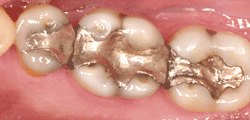Smile Gallery
Fillings | Bonding | Veneers | Crowns | Bridges | Implants
Fillings

Traditional dental restoratives (fillings) include gold, porcelain, composite, and amalgam. The strength and durability of traditional dental materials continue to make them useful for situations where restored teeth must withstand extreme forces that result from chewing, such as in the back of the mouth.
Newer dental fillings include ceramic and plastic compounds that mimic the appearance of natural teeth. These compounds, often called composite resins, are usually used on the front teeth where a natural appearance is important. They can be used on the back teeth as well depending on the location and extent of the tooth decay. Composite resins are usually more costly due to the increased time and expense to place them.
What's Right for Me?
Several factors influence the performance, durability, longevity and expense of dental restorations:
- The components used in the filling material
- The amount of tooth structure remaining
- Where and how the filling is placed
- The chewing load that the tooth will have to bear
- The length and number of visits needed to prepare and adjust the restored tooth.
The ultimate decision about what to use is best determined in consultation with Dr. Carol. Before your treatment begins, Dr. Carol will discuss these options with you. To help you prepare for this discussion it is helpful to understand the two basic types of dental fillings: direct and indirect.
- Direct fillings are fillings placed immediately into a prepared cavity in a single visit. They include dental amalgam, glass ionomers, resin ionomers, and composite (resin) fillings. Dr. Carol will prepare the tooth, place the filling, and adjust it during one appointment.
- Indirect fillings, which include inlays and onlays, used to require two or more visits. With the use of our CEREC machine, inlays and onlays can now be made in our office and cemented the same day, eliminating multiple appointments. Dr. Carol will prepare the tooth and take an image of the area to be sent to our milling unit where your restoration will be created out of porcelain. The restoration is then sculpted just for you so that your bite and jaw movements function normally once it is cemented.
Should a gold inlay or onlay be required an impression of the prepared tooth will be taken and sent to a dental lab, where a dental technician will fabricate the restoration. At your second visit, Dr. Carol cements or bonds the restoration into the prepared cavity and adjusts it as needed.

